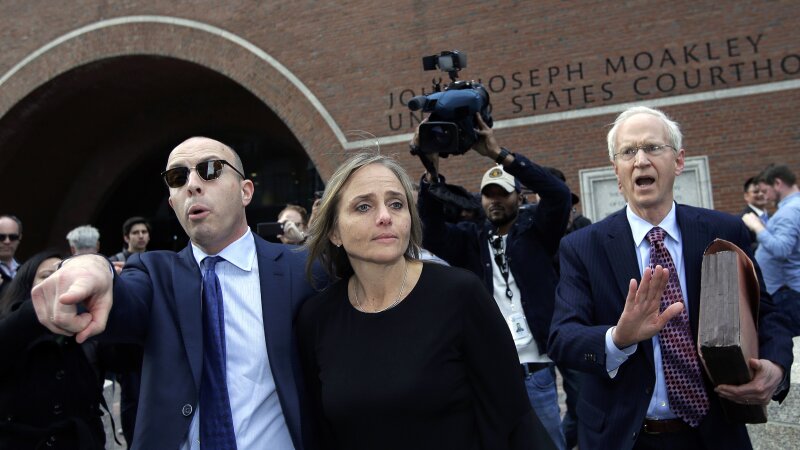District Court Judge Shelley Joseph leaves Boston federal court in April 2019 for allegedly helping a man in the country illegally evade immigration officials as he left her Newton, Mass., courthouse. Steven Senne/AP hide caption
News
Cassie Ventura (left) and Sean Combs at the Met Gala in New York City in 2017. Ventura testified for the prosecution in the criminal trial of Combs, who is charged with sex trafficking, racketeering conspiracy and transporting to engage in prostitution. Combs has pleaded not guilty to all charges. Neilson Barnard/Getty Images hide caption
People surround the bodies of Palestinians killed in an Israeli strike in front of the Indonesian hospital in Beit Lahia in the northern Gaza Strip, on Friday. Bashar Taleb/AFP via Getty Images hide caption
Relatives of victims hold a placard with photos of victims of the Ethiopian Airlines Flight 302 crash in March 2019, prior to a hearing in Fort Worth, Texas, in January 2023. Shelby Tauber/AFP via Getty Images hide caption
International Criminal Court chief prosecutor Karim Khan attends a United Nations Security Council meeting on Sudan and South Sudan in January in New York City. Michael M. Santiago/Getty Images hide caption
CEO of Tesla and SpaceX Elon Musk leaves the stage holding a chainsaw after speaking at the Conservative Political Action Conference (CPAC) on February 20. Andrew Harnik/Getty Images hide caption
In an aerial view, inmates are seen in the courtyard at the Bluebonnet Detention Center on May 12 in Anson, Texas. ICE has begun transferring illegal immigrant detainees to the Bluebonnet Detention Center after U.S. District Judge Wesley Hendrix readily offered the facility to the Trump administration under the Alien Enemies Act. Brandon Bell/Getty Images hide caption
A 2024 file photo of the U.S. Capitol. Bonnie Cash/Getty Images hide caption
Diddy performs onstage at the 2023 MTV Video Music Awards. Dia Dipasupil/Getty Images hide caption
President Trump and Saudi Crown Prince Mohammed bin Salman attend a bilateral meeting at the Saudi Royal Court on May 13 in Riyadh, Saudi Arabia. Win McNamee/Getty Images hide caption
Former FBI Director James Comey, shown here testifying before the Senate Intelligence Committee in June 2017, is under fire from conservatives for a social media post some interpret as a threat to President Trump's life. Chip Somodevilla/Getty Images hide caption
Daniel Berulis filed a whistleblower disclosure with Congress claiming that DOGE staffers compromised the NLRB's computer networks and may have taken sensitive data in the process. Grace Raver/NPR hide caption
Israeli singer Yuval Raphael is representing Israel at the Eurovision Song Contest. She performs "New Day Will Rise" during a dress rehearsal for the second semifinal in Basel, Switzerland, on May 14. Fabrice Coffrini/AFP via Getty Images hide caption
Novelist Salman Rushdie promotes the German-language edition of his book Knife: Meditations After an Attempted Murder in Berlin on May 16, 2024. In the book, Rushdie confronts the 2022 attack that left him blind in one eye. Sean Gallup/Getty Images hide caption
Children selling a drink made from hibiscus flowers in Jebel Aulia, a neighborhood on the outskirts of Khartoum where the last battles over control of the capital city took place. The Sudanese government took the city back from rebel forces in March. Faiz Abubakr for NPR hide caption
Caitlin Clark of the Indiana Fever and A'ja Wilson of the Las Vegas Aces are considered to be two of this year's leading MVP candidates. Ethan Miller/Getty Images hide caption
Activists demonstrate during a protest outside the U.S. Supreme Court on May 14 in Washington, D.C. The Supreme Court heard oral arguments on whether the Trump administration has the power to end birthright citizenship. Alex Wong/Getty Images North America hide caption
Birthright Citizenship Arguments, Trump's Mideast Trip, Sean 'Diddy' Combs Trial
Flamingos are filter feeders that live off shrimp, algae and other nibbles in wetlands around the world. Serhat Cetinkaya/Anadolu via Getty Images hide caption
Scientists have figured out why flamingos are such weird eaters
Merit Systems Protection Board member Cathy Harris (left) and National Labor Relations Board member Gwynne Wilcox (right) were fired by President Trump earlier this year. Mike Scarcella/Reuters; FM Archive/Alamy stock photo hide caption
President Franklin Delano Roosevelt circa 1930 at the White House. In the 1930s, FDR's "court packing" plan brought the U.S. to the brink of a constitutional crisis. /AFP via Getty Images hide caption
U.S. Army soldiers patrol the U.S.-Mexico border at Eagle Pass, Texas, on Jan. 24. The Trump administration has often used the word invasion to describe illegal immigration, but that framing has not been fully tested in court until now. Charly Triballeau/AFP via Getty Images hide caption
Residents of Marquette, a city in Michigan's Upper Peninsula, gathered outside Planned Parenthood to celebrate and thank staffers as they finished the last day of patient care on April 23. Bobby Anttila hide caption
New financial pressures forcing Planned Parenthood to close some clinics
From left: Halle Berry, POTUS, Pope Leo. Vittorio Zunino Celotto/Getty Images; Win McNamee/Getty Images; Franco Origlia/Getty Images hide caption
Kitty Horblit (left), Karli Manship (center) and Hannah Bruns (right) dance at Stud Country, a national queer line dancing event, on March 25, 2025, in Brooklyn, N.Y. Nickolai Hammar/NPR hide caption
























